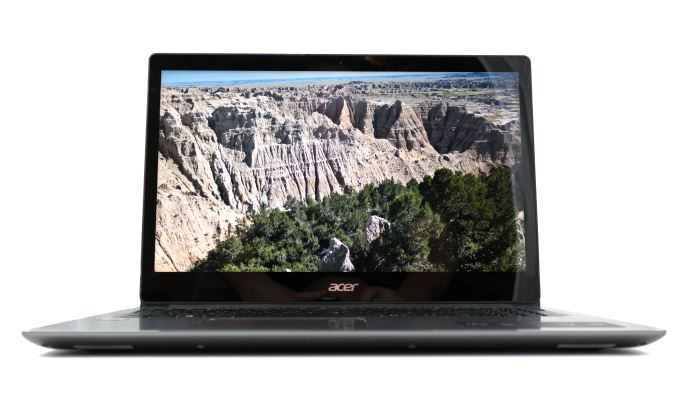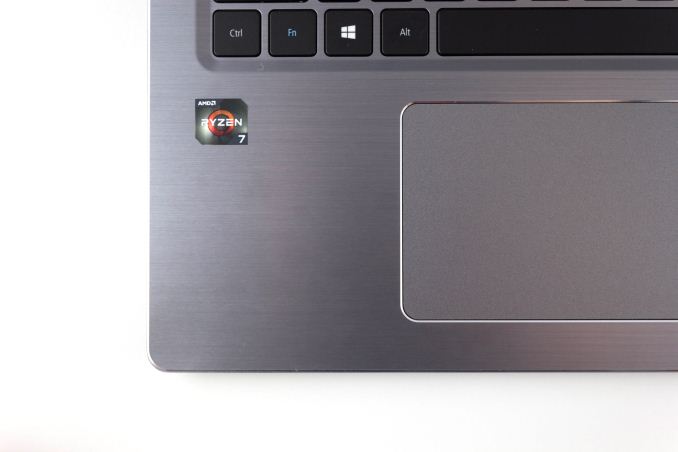The Acer Swift 3 SF315-41 Review: Ryzen Meets Laptop
by Brett Howse on May 3, 2018 8:00 AM EST- Posted in
- Laptops
- Acer
- AMD
- Ryzen
- Ryzen Mobile
- Raven Ridge

It’s been a long time since we’ve had a chance to review a laptop powered by an AMD CPU, but Acer has now launched the Acer Swift 3 powered by Ryzen Mobile, and we’ve got a chance to look at one. AMD has had a tough run in the laptop space over the last couple of years, but with the release of Ryzen in 2017, they are hoping to turn their fortunes around. But a big part of that will be having their partners package Ryzen into laptops that are of high quality, so that’s where Acer comes in.
Acer’s Swift 3 lineup is about middle of their lineup, which includes the Swift 1, 3, 5, and 7 models, and it’s a wide lineup, with Swift 3 models in both 14-inch and 15.6-inch versions, with both AMD processors with Vega graphics, as well as Intel processors, and some of those come with an optional NVIDIA GPU as well. For this review, we’ll be looking at the SF315-41-R6J9, which is a 15.6-inch version with the top-end AMD Ryzen mobile processors in the Ryzen 7 2700U.
AMD Ryzen 7 2700U is a quad-core processor with eight threads, and it has a base frequency of 2.2 GHz with a boost frequency of 3.8 GHz. It supports dual-channel DDR4-2400, and has 384 KB L1, 2 MB L2, and 4 MB L3 cache. But possibly the most exciting feature is the Radeon RX Vega 10 graphics, and in the 2700U it’s the largest GPU available with 10 GPU cores, and a boost frequency of 1300 MHz.
| Acer Swift 3 15 | |||||
| SF315-41-R8PP | SF315-41-R6J9 Model Tested |
SF315-51G-51CE | |||
| CPU | AMD Ryzen 5 2500U Quad-Core, Eight-Thread 2.0-3.6 GHz 15W TDP |
AMD Ryzen 7 2700U Quad-Core, Eight-Thread 2.2-3.8 GHz 15W TDP |
Intel Core i5-8250U Quad-Core, Eight-Thread 1.6-3.4 GHz 15W TDP |
||
| GPU | Radeon Vega 8 Compute Units Up to 1100MHz |
Radeon Vega 10 Compute Units Up to 1300MHz |
NVIDIA GeForce MX150 2 GB GDDR5 |
||
| RAM | 8 GB DDR4 | 8 GB DDR4 | 8 GB DDR4 (Standard) 16 GB DDR4 (Optional) |
||
| Storage | 256 GB SATA SSD | 512 GB SATA SSD | 256 GB SSD | ||
| Display | 15.6" 1920x1080 IPS | ||||
| Networking | 802.11ac Qualcomm QCA6174A 2x2:2 MU-MIMO Bluetooth 4.2 |
||||
| I/O | 2 x USB 3.0 1 x USB 2.0 1 x USB 3.1 Gen 1 Type-C HDMI SD Card Reader |
||||
| Battery | 48Wh, 45W AC Adapter | ||||
| Dimensions | 370 x 255 x 19.05 mm 14.59 x 10.04 x 0.74 inches |
||||
| Weight | 2.2 Kg 4.85 lbs |
2.2 Kg 4.85 lbs |
2.1 Kg 4.63 lbs |
||
| Pricing (MSRP) | $749.99 | $949.99 | $799.99 | ||
Acer’s top model of AMD based Swift 3 comes with enough connectivity in the USB-C port (Gen 1 - 5 Gbps) along with two USB 3.0 ports, and a USB 2.0 port. There’s also an HDMI output with HDCP, and a SD card reader, which is a solid amount of connections on a laptop.
While the 8 GB of RAM might seem a bit low, for this mid-range level of notebook, it’s likely enough. Acer also includes a fingerprint reader with Windows Hello support, and Wi-Fi based on the Qualcomm Atheros QCA6174A, which is a 2x2:2 802.11ac wireless NIC with MU-MIMO support and Bluetooth 4.2.
Before we take a deep dive into the performance, let’s first go over the design that Acer has created for the Swift 3.











78 Comments
View All Comments
jaydee - Thursday, May 3, 2018 - link
Looking forward to Ryzen hitting the business line notebooks (Elitebook/Latitudes). Lot of employees at my company are still being given the woeful Elitebook 745 G3 (Carrizo) as of today, as band new laptops for a 4 year cycle...Jimster480 - Monday, May 28, 2018 - link
They did, and the offerings are atrocious and insanely overpriced.Valantar - Thursday, May 3, 2018 - link
This is very promising in terms of performance, even if AMD still needs to convince OEMs to build more premium SKUs with Ryzen mobile. Also, that base platform power draw needs fixing, for sure. Wonder how much of that is RAM, but I suppose that would be pretty much impossible to measure.Related to that: why doesn't RAM have some sort of turbo/power saving implementation like CPUs? Given that this likely runs dual channel 1.2V DDR4 at ~2400MT/s, couldn't the base power draw benefit massively from downclocking the RAM to, say, 1600MT/s at idle and simultaneously lowering voltage? I get that this isn't part of the DDR4 spec, and that the ICs and DIMMs as such aren't tested or certified for lower voltages and speeds, but the lack of dynamism in RAM is starting to feel old. The same goes for high-speed desktop RAM, really - why run 3600MT/s RAM idling at the desktop? It can't possibly be /that/ hard to implement a two-state (e.g. "low power" and "normal") dynamic system that's directly tied to other system loads (not just CPU, but GPU, RAM, network and disk activity too). Tuning the boost/de-clock triggers and control algorithms would likely require a bit of work, but is this really that hard to do?
I suppose this could trip up a few applications that are highly reliant on timely RAM access, but those can't be very common in normal consumer usage - and I don't envision this catching on in datcenters and the like. Might that be why we still haven't seen something like this, as businesses and server OEMs don't care?
DanNeely - Thursday, May 3, 2018 - link
If idle link throttling of DDR ever happens, I'd expect it to happen first on mobile, and then work its way up though LPDDR, to regular DDR specs. OTOH GDDR has been able to do this for a while, so it's definitely doable without seriously impacting peak performance. GPUs are power pigs, and lower idle power has been a major improvement over the last decade; but it's a segment not willing to sacrifice performance at the top to get it.You're probably right about it never making it to the data center. I've read that a number of the major cloud platforms have disabled CPU clock throttling and run at full speed 24/7 regardless of the actual load because serving responses at low speed and/or boosting back up from idle to full speed have measurable impacts on latency and the major web companies care about every millisecond there.
neblogai - Friday, May 4, 2018 - link
Gaming benchmarks show mobile Raven Ridge processors doing exactly that: RAM clock changes in the game, 933-1066-1200. You can see such behaviour in TechEpiphany's videos on youtube. However- because this is not something seen before- these readings are semi-discarded. In would be great if someone tested it properly, or asked AMD if this is how it really works, and is not an error by monitoring software.HStewart - Thursday, May 3, 2018 - link
I think for comparison, it would have been nice to test the Intel version of same model - I found it interesting that 2700 version was more expensive than the Intel with MX150. Also the Intel model was less weight which tells me Intel components are more compact. The 2700 model had more ssd but that should not be that way.Cooe - Thursday, May 3, 2018 - link
It's because of the doubled SSD size that the 2700 model is more expensive obviously.Jimster480 - Monday, May 28, 2018 - link
Its not that because the AMD machines are relegated to cheap SATA bottom of the barrel drives and ultra cheap screens. The price is just Intel making sure that nobody is going to make a competitive notebook.This laptop doesn't even land in "mainstream" it lands in "ultra budget with such a big price nobody will buy it". The screen, SSD, battery, wifi, chassis, keyboard are all unacceptable for this price range and Acer knows it aswell. But the check they receive from intel outweighs the obvious lack of sales they will have for this model.
Stuka87 - Thursday, May 3, 2018 - link
I would be surprised if you could tell the weight difference between the two. Its 4 ounces. And the Intel is cheaper because its SSD is half the size.Krysto - Thursday, May 3, 2018 - link
Still only 8GB of RAM?! Come on.